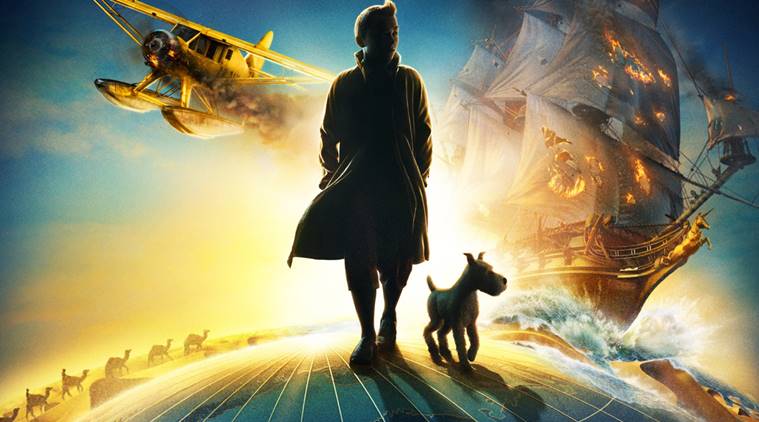
For every time I sat in front of a computer with lots of notes, a blank mind, a hack’s block, a ticking clock and a news editor screaming over an international line, there must have been a Tintin lurking in the room, laughing his red mop off. Don’t get me wrong. I was hooked on Tintin ever since my parents got me my first one, Tintin and the Shooting Star (1941), in which he sets off on a ship to find a meteorite that has crashed into the Arctic. And I, too, like travelling to exotic places more than writing about them. But hey, guess what? A foreign correspondent’s daily routine bears little resemblance to the serendipitous life of the greatest journalist to inhabit a comic strip.
Did anyone see this teenage smart-ass ever file a report? Who were his editor and news editor? And, very important, who was the accountant back in the office who never asked tiresome questions about expenses as this young lad in plus fours, accompanied by his dog and an alcoholic sea captain named after a fish, trotted across the world, from Tibet to South America and every country in between? He hired camels and private planes, sponged off friends in palaces, climbed the Himalayas, went on an underwater expedition looking for lost treasure. Heck, he even went to the moon, long before Neil Armstrong.
Most of Tintin’s journeys were more like fun holidays, a slightly more adult and funnier version of Enid Blyton’s Famous Five adventures. But unlike the five siblings and cousins who rarely left the English countryside, Tintin travelled to little-known far-off lands.
In a sense, Hergé, without leaving his studio in Brussels, was the true foreign correspondent behind Tintin, with his compelling stories about real and made-up places and their rulers such as Raja of Gaipajama.
He took people to the moon before NASA and wrote about genetic mutations well ahead of his time.
As a child growing up in Delhi, I had not heard about the Yeti until I read about the “abominable snowman”; never heard an opera singer till I met Bianca Castafiore at Marlinspike; never saw spaghetti until I saw Snowy slip and slide on some in the Shooting Star. And, though, I had no consciousness of it then, some of the stories must have been my introduction to the Cold War. In Tintin and the Picaros, for example, a deposed General Alcazar — with the help of revolutionary guerrillas or terrorists, depending on whose side you are on — is trying to mount an uprising against General Tapioca who had ousted him in a coup. There’s even a multinational called the International Banana Company.
My own foreign assignments took me on long tours to Sri Lanka and Pakistan, and while I won’t trade them for anything else in the world, they bore little resemblance to Tintin’s professional life, though the cast of characters one ran into sometimes did bring Hergé to mind. The two gentlemen, who tailed me everywhere in Islamabad, qualified eminently for the part of his twin detectives, who dived into an oasis in the middle of a desert only to discover it was a mirage. I even named my shadows Thomson and Thompson, after I caught them both peering up at me from behind a single Urdu newspaper in the parking lot of the Pakistan Supreme Court.
Tintin himself flashed before my eyes when I heard that two of my foreign correspondent colleagues, one British and another American, rode on camels to meet Nawab Ali Akbar Khan Bugti at his hideout in the caves of Balochistan some months before he was killed by the Pakistan army in 2006. There were a few Haddocks, too, the ones who drunkenly assured me that while I was in their company, I did not have to worry about the visa restrictions that curbed my own travel to Lahore and Karachi, but being no Tintin and with no Snowy to bail me out, I refused wisely to share their courage.
Hergé might have made something of my successful effort to transport my cat from Pakistan to India. It was a subplot at least if I could reveal half of what transpired. Or, of the first ever trip I made into LTTE territory in eastern Sri Lanka, riding pillion on the moped of a nervous Batticaloa youth, who I had persuaded to take me there. We ran over a green snake on the way, which seemed like an omen. But there was nothing remotely funny about the number of small children holding AK-47s I met there or the parents of child soldiers I interviewed.
As you can see, the typical foreign correspondent hitches rides, is stingy because money is short, and even while seemingly doing nothing, is hunting-gathering for stories, frantic about deadlines in time zones sometimes ahead and sometimes behind their impatient newsrooms. In short, no free trips.
This article appeared in print with the headline ‘Looking for Trouble: An ex-foreign scribe on the greatest reporter to grace a comic strip’